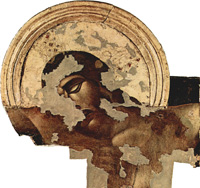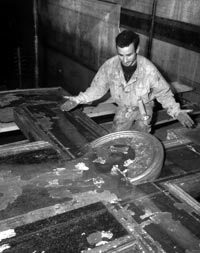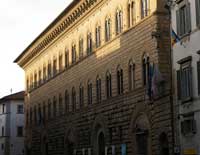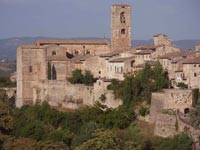| |
|
| |
|
|
In Florence, one can visit two Cimabue masterpieces: il Crocefisso di Santa Croce, seriously damaged during the 1966 flood, currently located at the Museo dell'Opera Santa Croce, as well as the Maestà, commissioned for the Church of Santa Trinita, currently located at the Uffizi.
This magnificent Basilica di Santa Croce, built in 1294 contains the tombs of many celebrated Florentines such as Michelangelo, Galileo, Ghiberti and Machiavelli. The Gothic interior is graced by the radiant frescoes of Giotto and his pupil Taddeo Gaddi and integrated into the cloister next to the church is Brunelleschi's Pazzi Chapel (Cappella de' Pazzi). When Lord Byron first laid eyes on the church he declared himself 'drunk with beauty'. [2] The Basilica interior houses the famous Trinità by Masaccio which, formulated within an architectural space conceived according to the perspective laws of Filippo Brunelleschi, constitutes another example of the happy union between drawing science and artistic expression.
Due to its geographical location, Florence has often been the victim of flooding. The 1844 flood has left a particularly lasting memory, even though the peak of the flooding remained significantly below the peak recorded on November 4, 1966. Due to its geographical location, Florence has often been the victim of flooding. The 1844 flood has left a particularly lasting memory, even though the peak of the flooding remained significantly below the peak recorded on November 4, 1966.
The symbol of the devastating effects of the flood is the almost complete destruction of the huge Crucifix by Cimabue. The crucifix, painted in distemper on wood (around 1272) by one of the most significant painters of the 13th century, had lost the majority of its layer of paint. The first action taken was to move this work of art from the former Santa Croce refectory to the Limonaia in the Giardino di Boboli. In 1976, the Crucifix underwent a major restoration, during which it was possible to conserve the remains of the layer of paint. [3]
|
|
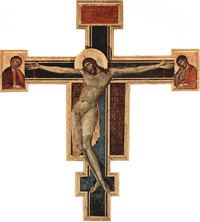
Cimabue, Crocifisso, 1280, tempera su tavola, 390 cm, basilica di Santa Croce, Firenze
|
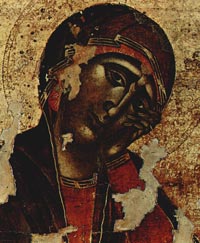 |
|
|
|
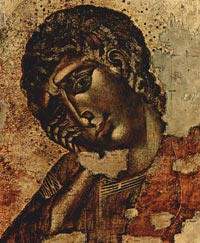 |
|
Madonna
|
|
|
|
San Giovanni |
| Vasari and others cited this crucifixion as an example for Cimabue's innovation: for breaking away from the Byzantine style and achieving a powerful new connection to Christ's humanity and emotion. Time damaged the piece badly, and a flood invaded Santa Croce in 1966 and removed much of the paint. |
|
|
|
|
| |
|

[1] Cimabue, or Bencivieni Di Pepo was the last great Italian artist in the Byzantine style, which had dominated early medieval painting in Italy. Among his surviving works are the frescoes of New Testament scenes in the upper church of S. Francesco, Assisi, the “Santa. Trinita Madonna” (c. 1290, Uffizi, Florence); and the “Madonna Enthroned with St. Francis” (c. 1290–95, lower church of S. Francesco).
Cimabue's style provided the firm foundation upon which rested the art of Giotto and Duccio in the 14th century, although he was superseded in his own lifetime by these artists, both of whom he had influenced and perhaps trained. His great contemporary, Dante, recognized the importance of Cimabue and placed him at the forefront of Italian painters. Giorgio Vasari, in his Lives of the Most Eminent Italian Painters, Sculptors, and Architects (1550), begins his collection of biographies with the life of Cimabue. Art historiographers from the 14th century to the present have recognized the art and career of Cimabue as the dividing line between the old and the new traditions in western European painting.
The earliest biography of Cimabue, by Vasari, states that he was born in 1240 and died in 1300. The dates can only be approximations, for it is documented that Cimabue was aliveand working in Pisa in 1302. The only other document relative to his life identifies him as a master painter and witness to a document signed in Rome in 1272. From this it can be concluded that he was born prior to 1251. Other documents indicate that he was christened Bencivieni di Pepo, or Benvenuto di Giuseppe in modern Italian. Cimabue was a nickname that through an error later became a family name.
Nothing is known of his early training. Vasari's assertion thathe was apprenticed to Greek Byzantine painters living in Italy is probably an attempt to explain both the style and the sudden emergence of this genius. He was certainly influenced by the Italo-Byzantine painter Giunta Pisano and by Coppo di Marcovaldo and may have been an apprentice to Coppo.
Cimabue's character may be reflected in his name, which canperhaps best be translated as “bullheaded.” An anonymous commentator in a work on Dante written in 1333–34 said that Cimabue was so proud and demanding that if others found fault with his work, or if he found something displeasing in it himself, he would destroy the work, no matter how valuable. It is perhaps significant that in the Divine Comedy Dante places Cimabue among the proud in Purgatory. And the poet refers to him to illustrate the transience of earthly fame: “Cimabue thought to hold the field in painting, and now Giotto hath the cry.” But pride in his own accomplishments and a high personal standard of excellence separated Cimabue from the anonymous artists of the Middle Ages.
Only Cimabue's last work, the mosaic of “St. John the Evangelist,” in the Duomo of Pisa, is dated (1301–02). The large “Crucifix,” in S. Domenico, Arezzo, is generally accepted as his earliest work and datable before 1272. The frescoes in the upper church of S. Francesco, Assisi, were probably executed between 1288 and 1290. The period 1290–95 includes the large “Crucifix” for Sta. Croce in Florence—about 70 percent destroyed in the floods of 1966, though restoration has been completed; the “Sta. Trinita Madonna,” an altarpiece now in Florence's Uffizi; and the “Madonna Enthroned with St. Francis,” in the lower church of S. Francesco at Assisi.
Despite the small number of Cimabue's works that have survived, they fully support the reputation that the artist has acquired. In certain formal or more “official” commissions, such as crucifixes and large altarpieces, Cimabue adhered closely to the formal vocabulary of the Byzantine tradition. And yet he breathes new emotive content into the abstract or stylized forms. In the fresco cycle at Assisi, Cimabue found an especially receptive patron, for the art commissioned by the Franciscans from Cimabue's time on is generally characterized by a dramatic and emotive narrative.
Along with the traditional stylization of the human form, Cimabue seems to have been among the first to return to a close observation of nature. In a highly formal altarpiece such as the “Sta. Trinita Madonna,” he introduces at the baseof the throne four prophets who are modelled through light and dark in a highly sculptural manner that seems far in advance of its date. Cimabue seems also to have been one of the first to recognize the potentialities of painted architecture, which he introduced into his scenes to give an indication of place and a heightened sense of three-dimensionality. The fresco “The Four Evangelists,” in the vault of the crossing of the upper church at Assisi, is sculpturally conceived, but its solidity and bulk are heightened by the crystalline city views that accompany each of the figures. The view of Rome that accompanies St. Mark, for example, is not only one of the earliest recognizable views of the city but is also one of the first in which the buildings seem solid and separated one from the other by a clearly defined space. This concern with the illusion of space and with a three-dimensional form occupying that space is rarely met with in medieval painting prior to Cimabue, but it is highly characteristic of Cimabue's leading student and rival, Giotto.
In Cimabue's more formal works he follows tradition closely, but he brings to that tradition a heightened sense of drama. After him the Byzantine tradition in Italy died out, partly because it had been superseded by a new style, but also because he had exhausted all the possibilities inherent in the tradition. In his less formal works he was able to exploit agrowing interest in narrative that had been inherent in the Byzantine tradition but never fully developed. Finally, he brought to Italian painting a new awareness of space and of sculptural form. By his own personality and by his contributions to painting he merits Vasari's characterization of him as the first Florentine painter and the first painter of “modern” times.
John R. Spencer (Encyclopaedia Britannica)
[2] The Basilica di Santa Croce, traditionally attributed to Arnolfo di Cambio, was built from 1295, on the site where, around 1210, the first Franciscan friars to arrive in Florence had a small oratory. The Basilica di Santa Croce is situated on the Piazza di Santa Croce, about 800 metres south east of the Duomo. The site, when first chosen, was in marshland outside the city walls. It is the burial place of some of the most illustrious Italians, such as Michelangelo, Galileo, Machiavelli, Foscolo, Gentile and Rossini, thus it is known also as the Temple of the Italian Glories (Tempio dell'Itale Glorie). The Museo dell'Opera di Santa Croce is housed mainly in the refectory, also off the cloister.
Michelangelo, who died in Rome in 1564, was buried here beneath a monument with allegorical figures of Sculpture, Architecture and Painting, designed by Giorgio Vasari. Michelangelo’s tomb served as the model for others, such as the tomb of Galileo, who died in 1642 (his monument was made by Giovanni Battista Foggini).
Funerary monuments continued to be added to the interior, including ones to Niccolò Machiavelli, Vittorio Alfieri, Gioachino Rossini and the cenotaph to Dante Alighieri (1829). Ugo Foscolo, who died in England, was reburied here in 1871; in his celebrated Sepolcri he had written of the Santa Croce tombs as ‘urns of the strong, that kindle strong souls to great deeds’, and had thereby given rise to the secular view of the basilica as a Pantheon of civic memories.
In the second half of the 15th century, Leon Battista Alberti was entrusted with completing the facade of the Basilica di Santa Croce, where he admirably harmonised the medieval elements and the new parts contained in his project. The relationships of the parts amongst themselves and with the entirety are established by a harmonic proportional system derived from simple ratios (one to one, one to two, one to three, etc.), which are at the basis of musical harmony. This system permitted Alberti to define the position and dimension of every element of the facade. The one-to-two relationship governs the composition of the entire facade, which appears inscribed in a square, while a smaller square (with sides equal to half that of the larger square) establishes the relationship between the two floors, breaks up the lower part, and circumscribes the upper central part. This ratio is maintained for all the elements of the facade, so that it appears built geometrically on the basis of a progressive halving or doubling of the measurements, always maintaining the same proportion.
|
[3] Due to its geographical location, Florence has often been the victim of flooding. The 1844 flood has left a particularly lasting memory, even though the peak of the flooding remained significantly below the peak recorded on November 4, 1966.
The staggering damage to the famous Ponte Vecchio illustrates the extent of the flood catastrophe. The washed over riverbanks, the destruction of the bridges over the Arno River, rubble, refuse, and mud at the Uffizi Gallery and in the quarters of the city close to the river all document the enormous efforts of the helpers who came to the city on the Arno directly after the flood: Soldiers untiringly attempt to remove the mud from the interior of a church; Innumerable volunteers, admiringly and gratefully named the ‘Angeli del fango – angels of the mud’, help to rescue the art treasures .
|
 |
|
|
The Kunsthistorisches Institut in Florence | The Flood of 1966 | Santa Croce | Cimabue’s Crucifix
This dramatic event in the recent history of the city of Florence is portrayed in the online exhibition based on the comprehensive inventory of the photo library. Significant is that the photographs are much more than mere witnesses of the catastrophe. The photographic eye reveals unexpected perspectives of the devastation and losses. The stunned amazement and horror of the observer of the destructive forces of nature are expressed in these photographic works.
The photographer Ivo Bazzechi, who took most of the photographs exhibited here, recorded his impressions during the flood. The photographs record the situation during and after the catastrophe, in which immense damage was inflicted on streets, plazas, buildings, and works of art. In particular, the primary aim of the collection of photographs shown here is to highlight the damage and destruction inflicted on works of art, such as those in the Santa Maria Novella and Santa Croce churches, or inflicted on individual works, such as the almost completely destroyed Crucifix by Cimabue. The symbol of the devastating effects of the flood is the almost complete destruction of the huge Crucifix by Cimabue. The crucifix, painted in distemper on wood (around 1272) by one of the most significant painters of the 13th century, had lost the majority of its layer of paint. The first action taken was to move this work of art from the former Santa Croce refectory to the Limonaia in the Giardino di Boboli. In 1976, the Crucifix underwent a major restoration, during which it was possible to conserve the remains of the layer of paint.
The exhibition in the Kunsthistorisches Institut documents the flood’s immediate aftermath and the ramifications for the city and its artistic treasures. The first section depicts the damage and destruction suffered by the works of art themselves. The second selection illustrates the devastation of the city and its streets, alleys, squares and houses.
The majority of the exhibition’s 80 photographs, taken by Ivo Bazzechi, date from the dramatic days following the flood.
|
|
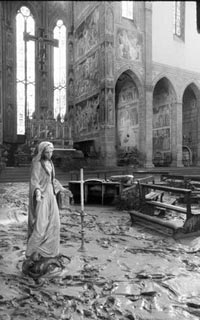 Interior of the Basilica of Santa Croce,
6 Nov 1966 |
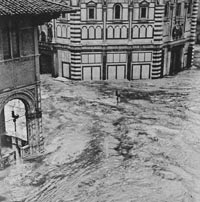 View onto the Baptistery and the Loggia del Bigallo (Photographer Bazzechi) View onto the Baptistery and the Loggia del Bigallo (Photographer Bazzechi) |
|
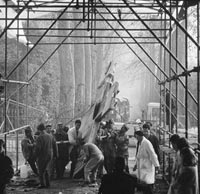
Transportation of the crucifix to the limonaia of the Giardino di Boboli (Photographer Bazzechi) |
|
|
| |
|
|
|
|
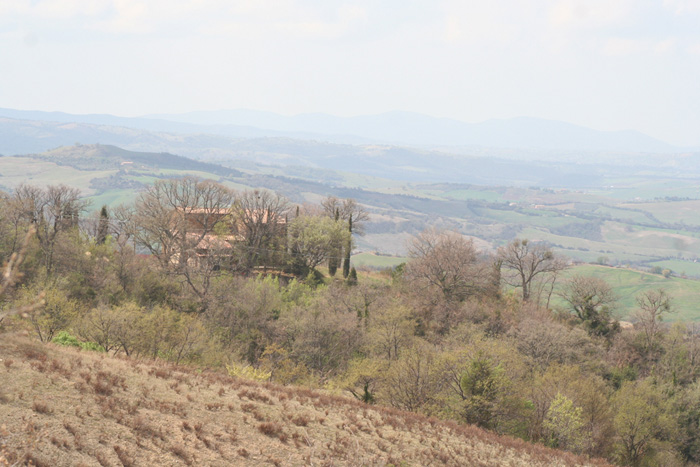 |
Podere Santa Pia, with its wide panoramic terrace overlooking the Maremma, is the ideal place to enjoy the beauty of Tuscany
|

Holiday accomodation in Tuscany | Podere Santa Pia | Artist and writer's residency
|
| |
|
|
|
|

. |
|
|
Podere Santa Pia |
|
Podere Santa Pia, garden view, December |
|
View from terrace with a stunning view over the Maremma and Montecristo |
| |
|
|
|
|
|
|
|
|
|
Palazzo Medici Riccardi, Florence |
|
Colle di Val d'Elsa |
|
Florence, Duomo
|
 |
|
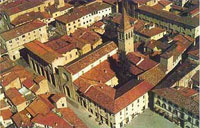
|
|
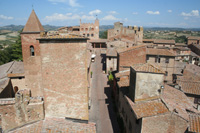 |
San Gimignano
|
|
Sansepolcro |
|
Certaldo |
| |
|
|
|
|
|
|
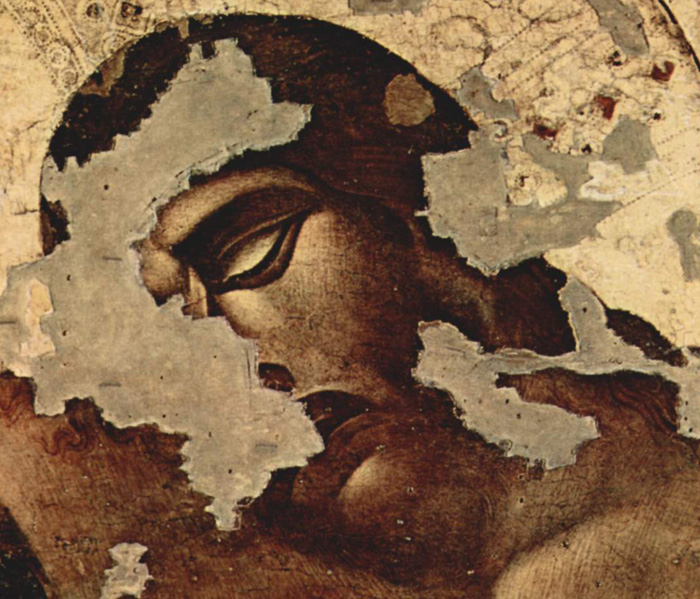


 Interior of the Basilica of Santa Croce,
Interior of the Basilica of Santa Croce, 





